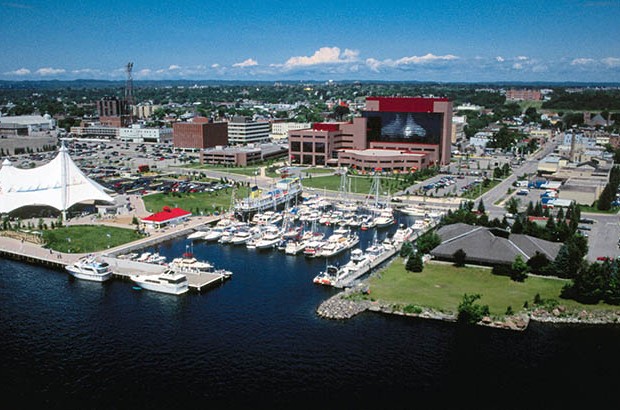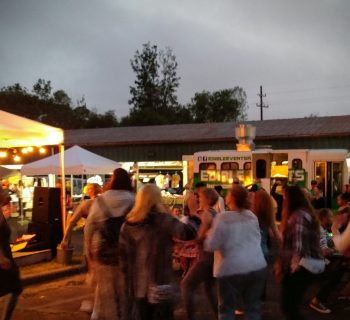
Sault Ste. Marie in Michigan's Upper Peninsula was the last of six scheduled cities on 2014's Michigan Transportation Odyssey. The theme of the Oct. 8 stop was connectivity—how different projects link together people and places in a region.
Unfortunately, mechanical difficulties prevented the Odyssey group's bus from reaching their final destination. Thankfully, speakers went on with the event at Lake Superior State University (LSSU) and shared a recorded version with Mode Shift.
The attendees at LSSU discussed biking and multi-use pathways, non-motorized travel among LSSU students and transportation initiatives by the Sault Ste. Marie Chippewa Indian tribe.
The first presenter was Wayne Barry, Chairman of the Sault Ste. Marie Area Recreational Trails, who began by commenting on the area's appeal to bicyclists.
"We have clean air, clean water, great resources and many cyclists come here because we have less traffic on our roads," Barry told the gathering.
One of the things connecting visitors and residents who happen to bike through and around the area is U.S. Bicycle Route 35, a 500-mile trail bike route running from Sault Ste. Marie to Indiana's border. Part of a larger national system of bike routes, it runs along I-75 from Sault Ste. Marie to St. Ignace in the Upper Peninsula, then goes west, generally following the coast of Lake Michigan from Mackinaw City to New Buffalo.. The Michigan portion was dedicated in 2012, and there are plans to extend the route down to Mississippi.
Travelers can also ride to Canada via the Sault Ste. Marie International Bridge, which allows bike crossing.
Dave Rusch of MDOT spoke about widening the Easterday Ave. I-75 overpass to make way for a multi-use path. With the assistance of state and federal authorities, the city is expanding and connecting a network of bike trails and multi-use pathways in accordance with its 2012 nonmotorized plan.
LSSU biology professor Greg Zimmerman praised these developments and noted his own institution's efforts to encourage walking and bicycle travel.
The university has created a number of trails in the campus woodlands for hiking, biking and cross-country skiing. It also rents out bicycles, snowshoes and ski gear at affordable rates.
"It's to get our students up and around," Zimmerman says, "but also to get people visiting, to think of it as a place you can do non-motorized recreation and connect LSSU with the town."
Although the trails are not currently linked to the city's wider multi-use path network, Zimmerman says there is definitely potential to do so. He also remarked on recent pedestrian-vehicle collisions on the campus and the need to develop infrastructure to address the problem.
Last up was Wendy Hoffman, Transportation Planner for the Sault Ste. Marie tribe of Chippewa Indians.
Headquartered in Sault Ste. Marie, the 44,000-member tribe covers a seven-county area in Michigan's Upper Peninsula. Although the tribe frequently collaborates with federal, state and local governments on transportation issues, connectivity remains a concern for many members.
"There's a really great need for connecting all our residents, especially with transit," Hoffman told the crowd.
While there is a long-distance bus provider in the region, Indian Trails, its service concludes at 4 p.m. each day. Hoffman said those hours are unfeasible for those who depend on bus service to get around, especially during the U.P.'s unforgiving winter months. At the time of the presentation, her tribe was conducting a transit study exploring different alternatives for expanding coverage. Launching a tribe-operated service was one option, along with various degrees of working with existing providers.
When it comes to addressing the transportation needs, the Sault aren't worried about getting their feet wet either. During her talk, Hoffman also mentioned some exciting transportation initiatives involving the region's lakes and rivers.
Right now the tribe is joining with other governmental entities to chart different water access points for kayaking and other water travel on Lake Superior. They intend to create a water trail system that can be accessed online via the michiganwatertrails site.
It's seen as a wonderful opportunity to educate people about traditional names and knowledge regarding the waterways, as well as a way to stimulate the region's economy through placemaking and tourism.
"It's really important that the local communities and businesses buy into this, because it's going to benefit them," she said.
The tribe also hopes to participate in an event called Great Lakes Circle Tour in July 2017, which will encourage folks to navigate waterways like Lake Superior and the local St. Mary's River.
Despite some challenges with traffic and a lack of long-distance transit coverage, it's clear Sault Ste. Marie is making strides with connectivity. Projects like the cross-country bike route and the charting of local waterways point to a more holistic transportation future in the region, for residents and visitors alike.










